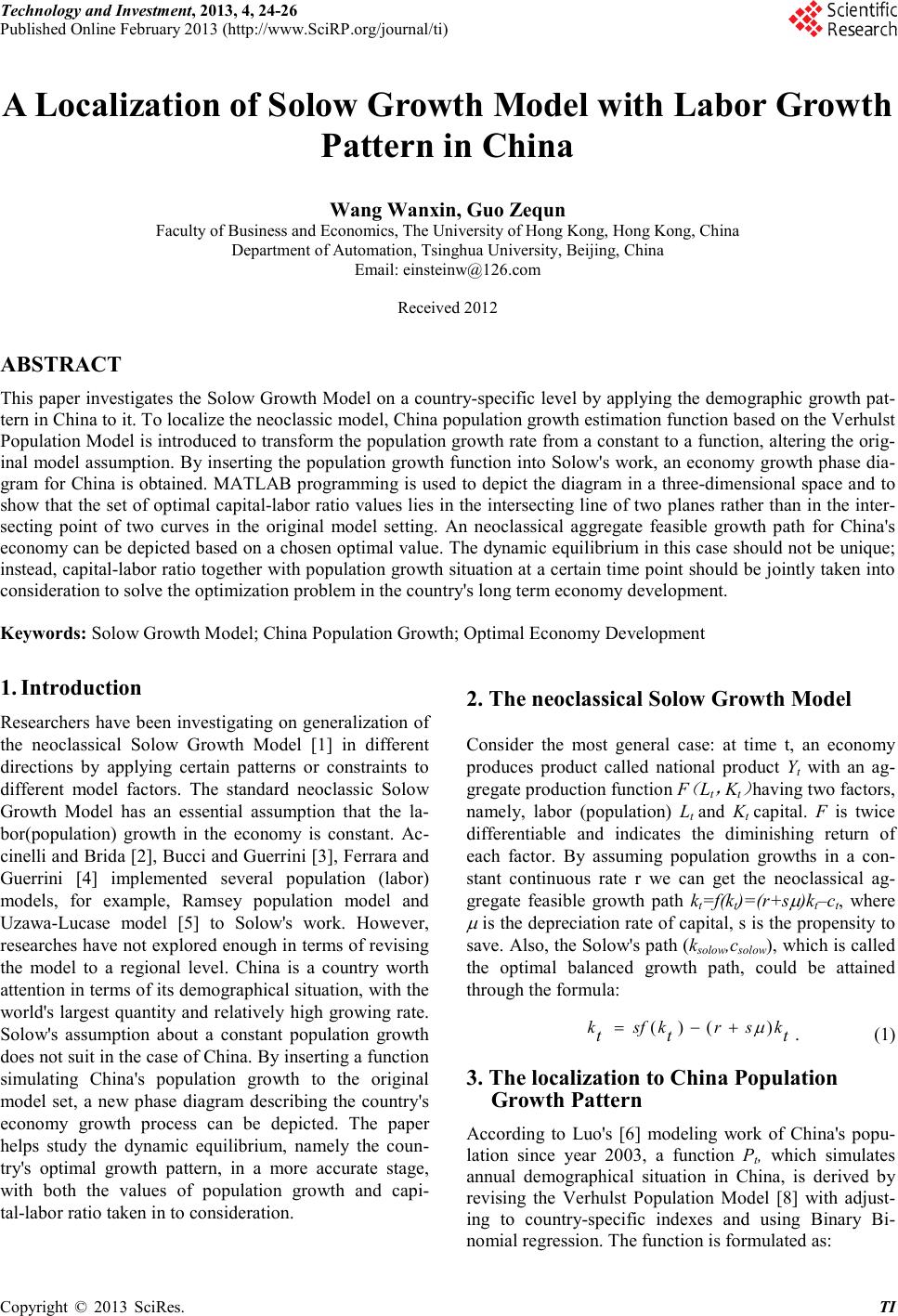
Technology and Investment, 2013, 4, 24-26
Published Online Febr uary 2013 (http://www.SciRP.org/journal/ti)
Copyright © 2013 SciRes. TI
A Localization of Solow Growth Model with Labor Growth
Pattern in China
Wang Wanxin, Guo Zequn
Faculty of Business and Economics, The University of Hong Kong, Hong Kong, China
Department of Automation, Tsinghua University, Beijing, China
Email: einsteinw@126.com
Received 2012
ABSTRACT
This paper investigates the Solow Growth Model on a country-specific level by applying the demographic growth pat-
tern in China to it. To localize the neoclassic model, China population growth estimation function based on the Verhulst
Population Model is introduced to transform the population growth rate from a constant to a function, altering the orig-
inal model assumption. By inserting the population growth function into Solow's work, an economy growth phase dia-
gra m for China is obtained. MATLAB programming is used to depict the diagram in a three-dimensional space and to
show that the set of optimal cap ital-labor ratio values lies in the intersecting line of two planes rather than in the inter-
secting point of two curves in the ori ginal model setting. An neoclassical aggregate feasible growth path for China's
economy can be depicted based on a chosen optimal value. The dynamic equilibrium in this case should not be unique;
instead, capital-labor ratio together with population growth situation at a certain time point should be jointly taken into
consideration to solve t he optimization problem in the country's long term economy development.
Keywords: Solow Growth Model; China Population Growth; Optimal Economy Developmen t
1. Introduction
Researchers have been investigating on generalization of
the neoclassical Solow Growth Model [1] in different
directions by applying certain patterns or constraints to
different model factors. The standard neoclassic Solow
Growth Model has an essential assumption that the la-
bor(population) growth in the economy is constant. Ac-
cinelli and Brida [2], B ucci and Guerrini [3], Ferrara and
Guerr i ni [4] implemented several population (labor)
models, for example, Ramsey population model and
Uzawa-Lucase model [5] to Solow's work. However,
researches have not explored enough in terms of revising
the model to a regional level. China is a country worth
attention in terms of its demographical situation, with the
world's largest quantity and relatively high growing rate.
Solow's assumption about a constant population growth
does not suit in the case of China. By inserting a function
simulating China's population growth to the original
model set, a new phase diagram describing the country's
economy growth process can be depicted. The paper
helps study the dynamic equilibrium, namely the coun-
try's optimal growth pattern, in a more accurate stage,
with both the values of population growth and capi-
tal-labor ratio taken in to consideration.
2. The neoclassical Solow Growth Model
Consider the most general case: at time t, an economy
produces product called national product Yt with an ag-
gregate production function F
(
Lt
,
Kt
)
having two factors,
namely, labor (population) Lt and Kt capital. F is twice
differentiable and indicates the diminishing return of
each factor. By assuming population growths in a con-
stant continuous rate r we can get the neoclassical ag-
gregate feasible growt h path kt=f(k t)=(r+ s
µ
)kt–ct, where
µ
is the depreciation rate of capital, s is the propensity to
save. Also, the Solow's path (ksolow,csolow), which is called
the optimal balanced growth path, could be attained
through the formula:
. (1)
3. The localization to China Population
Growth Pattern
According to Luo's [6] modeling work of China's popu-
lation since year 2003, a function Pt, which simulates
annual demographical situation in China, is derived by
revising the Verhulst Population Model [8] with adjust-
ing to country-specific indexes and using Binary Bi-
nomial regression. The function is formulated as: